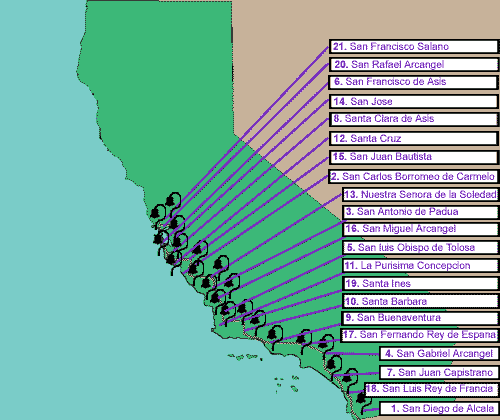

|
|
Select photographs of my many visits to The Missions of the United States South and Southwest built by Spain and Mexico between 1565 and 1823. All photographs taken by Kenneth A. Larson. All rights reserved. © 2008 - 2013. |
| Explanation. |
| This site is in development. These pages are unfinished and many links to other pages lead to incomplete or missing pages - use the back button. In most cases, these unfinished pages are updates of the corresponding pages atMission Trail Today, so sometimes contain more information and photos. |
|
Main California Page
|
|
By Founding Date
| ||
|
South to North
| ||
|
- - -
|
- - -
|
| This section is dedicated to the California missions and related constructions built by Spain and Mexico* in the late 1700s and early 1800s. The missions are an important chapter of California history and it would be impossible to understand the California story without understanding the |

|
|
missions story. Modern California began with the founding of the first mission in San Diego in 1769 and many major cities grew up around the missions or their outlying ranchos. * Most of the missions were built by Spain, however, San Francisco Solano was built by Mexico after the Mexican Revolution. |
| A note: There are no historical photographs on this web site. All of these photographs are taken by myself, and while I may feel two hundred years old, I simply didn't have a camera when the missions were built or when most were restored. These photographs are of the missions as they exist today or within the last third century. I include historical text as a summary to give you a quick overview and place the photographs in historical context. There are several good internet sites and books that can provide historic photographs and art work and more in depth histories. I do believe that I have included here more photographs of the way the missions look today than most of the other sites and books. This site can be used as a guide for you and your family to visit the missions which is why I originally named it Mission Trail Today. So study these pages and web sites by others and pack up your car and your family and visit the missions. All of the missions are open to the public, most daily 10:00 am - 5:00 pm. Many are still in use as parish churches and hold mass regularly. |
Personal Observations |
 My collection of Mission Art |
| asistencias or sites, 3 presidios, 1 pueblo, driven most of the El Camio Real, and visited the sites of the two missions of the Colorado River. We hope to revisit all of them again and I will return to the missions as long as I am able. We also hope to find more Asistencias and Estancias and other mission related constructions. We have visited Missions or Mission sites in Arizona, Texas, Louisiana, and Florida. Someday, we hope to visit more Missions in Arizona and Texas, and visit New Mexico and the east coast. |
| I am behind with scanning my slides but hope to get caught up soon, so stay tuned. I have not yet had time to scan the slides from almost a dozen missions, so check back. More text and photographs will be added in time. |
|
About 30,000 years ago, give or take a few millennia, people from northeast Asia traveled across the Bearing Land Bridge into what we now call North America. Within a relatively short time, they had populated all of North and South America and the major off shore islands. They organized themselves into nations and tribes and more or less got along and lived in harmony with the Earth. While not well documented, it seems likely that Europeans had visited the eastern shore of North America prior to the voyage of Christopher Columbus in 1492. It was Columbus' discoveries that brought the Americas to the attention of Europe and it was not long before all the major nations of Europe were setting up colonies in the Americas. Spain claimed the most territory including most of the west coast of both continents and parts of the Caribbean. This included what is now the United States Southwest. Spain established missions and settlements throughout its holdings for two primary reasons, first, to bring Christianity to the indigenous people, and second, to help strengthen Spain's claim to the territories also coveted by France, Britain, Russia, and the United States. The famous Alamo in San Antonio, Texas is one of several missions build in Texas. Missions and churches were also established in Arizona, New Mexico, and the US southeast as far north as Virginia. A chain of missions eventually extended from to southern tip of South America north into Northern California. Because Russian influence and settlements were moving south along the west coat of North America, Spain felt it needed to act to stop the Russian encroachment into the area we now call California. Spain already had established missions along much of the west coast of the Americas so in 1769 it extended the chain north, establishing the first Mission and town in what has become California. Spain built 20 missions in Alta California along with a number of Asistencias and Estancias (Extension or sub-missions Missions and outlying ranches). Four Presidios were built and three Pueblos were established. The chain of missions in California was joined by El Camino Real ("The King's Highway"), which is the approximate route of modern day Highway 101 along the California Coast. Following the Mexican Revolution in 1821, the new Mexican government decided to build one last mission in 1823 to head off encroachment by Russia from the north. Within a few short years, this new mission and all the others were stripped of their property when Mexico secularized the missions in 1834. This was the end of the mission period. The missions did not end in 1834. The buildings were used by the new owners, often as ranch buildings, but eventually, most fell into disrepair. President Lincoln, despite pressing issues in the east, returned many of the missions to the Catholic Church, but deterioration continued. In the twentieth century, interest developed among the public to preserve and restore these historically significant buildings. Some are now complete reconstructions, some on new sites. During the Great Depression of the 1930s, WPA projects restored some of the missions such as La Purisima and the Estancia of San Bernardino was rebuilt into the Asistencia we see today. Today, all of the missions have been restored to various degrees. Most are in the hands of the Catholic church, some are in California State Historical Parks. Many still have active parishes and one, the Extension Mission of San Antonia de Pala, still serves an Indian population as the Padres had intended. All are open to the public and should be visited by anyone interested in California history. |
|
Charles V issued the code of "New Laws" which later became the foundation of the California mission system. It stated that the Indians should be permitted to live in communities of their own; they should be permitted to choose their own leaders and councilors; no Indian to be held as a slave; no Indian to live outside his own village; no Spaniard to stay in an Indian village for more than three days, and then only if he were a merchant or ill; and the Indians to be instructed in the Catholic faith. Religious communities were established in Mexico (which then included California) and Central America. The missionaries were self-supporting and helped secure the frontiers from intrusions. By 1700, the Jesuits had established a chain of missions along the coast of Baja (Lower) California to about the present US-Mixico border. In time, the Jesuits were replaced in Mexico by the Franciscans. It was the Franciscans who were to extend the mission system into Alta (Upper) California under the control of and in cooperation with Spanish authorities. It was not until 1769 that the first Mission was founded in San Diego. The establishment of the missions in Alta California was not authorized until the threat of Russian encroachment into the area was realized. Spain sent padres, a handful of soldiers and a few supplies into Alta California to establish a presence. The Franciscans not only brought Christianity to the native population, but to teach them new skills so they could become productive citizens for Spain. Miguel Joseph Serra was born November 24, 1713 at Petra, Majorca, in Spain's Balearic Isles. Upon taking his religious vows in 1730, Serra took the name Junípero, after a beloved disciple of St. Francis of Assisi. Junípero Serra and Governor Portola developed the plan to extend the chain of missions northward into Alta California and secure the Spanish domain as far north as modern day Sonoma. Three ships and two land expeditions set out for modern day San Diego in 1769. Padre Junípero Serra and the governor, riding on mules, were in the second land party. After enduring the hardship of crossing the desert of what is now Baja California, both land parties reached San Diego Bay where two of the ships awaited them. The crews and soldiers were badly decimated by scurvy. The third ship was lost. The mission system thrived for 65 years. Under Spanish rule, 20 missions were built in addition to a number of "asistencia" (Extension) Missions. One mission, San Francisco Solano, was established after Mexican independence. After Mexico won its independence from Spain in 1821, the law of secularization was passed. The simple idea behind the law was that each mission was given ten years to fulfill its function of instructing the Indians. After this time, the missions were to be replaced by another colonial institution, the pueblo. This last step was long overdue in Alta California. Secularization began in 1833. The law stated that the land was to be handed over to the Indians. When California became part of the United States in 1850, the Catholic Bishop of California petitioned the U.S. government for the return of the missions. None of the missions returned to their former glory. This Early California History section derived in part from The California Mission Site. Ed. The Civic Group. 24 Sept. 1998. |


|
#21 #20 #6 #14 #8 #12 #15 #2 #13 #3 #16 #5 #11 #19 #10 #9 #17 #4 #7 #18 #1 |





#1, San Diego de Alcalá. Founded July 16, 1769 by Father Junipero Serra. San Diego. |


#2, San Carlos Borromeo de Carmelo. Founded June 3, 1770 by Father Junipero Serra. Carmel. |


#3, San Antonio de Padua. Founded July 14, 1771 by Father Junipero Serra. Monterey County. |

#4, San Gabriel Arcángel. Founded September 8, 1771 by Father Pedro Cambon and Father Angel Somera. San Gabriel. |


#5, San Luis Obispo de Tolosa. Founded September 1, 1772 by Father Junipero Serra. San Luis Obispo. |

#6, San Francisco de Asis (Mission Dolores). Founded September 1, 1772 by Father Francisco Palóu. San Francisco. |

#7, San Juan Capistrano. Founded November 1, 1776 by Father Junipero Serra. Capistrano. |


#8, Santa Clara de Asis. Founded January 12, 1777 by Father Junipero Serra. Santa Clara. |

#9, San Buenaventura. Founded March 31, 1782 by Father Junipero Serra. Ventura. |


#10, Santa Barbara. Founded December 4, 1786 by Father Fermin Lasuen. Santa Barbara. |


#11, La Purisima Concepción. Founded December 8, 1787 by Father Fermin Lasuen. Lompoc. |


#12, Santa Cruz. Founded August 28, 1791 by Father Fermin Lasuen. Santa Cruz. |

#13, Nuestra Sonora de la Soledad. Founded October 9, 1791 by Father Fermin Lasuen. Soledad. |

#14, San José. Founded June 11, 1797 by Father Fermin Lasuen. Mission San Jose. |

#15, San Juan Bautista. Founded June 24, 1797 by Father Fermin Lasuen. San Juan Bautista. |

#16, San Miguel Arcángel. Founded July 25, 1797 by Father Fermin Lasuen. Paso Robles. |

#17, San Fernando Rey de España. Founded September 8, 1797 by Father Fermin Lasuen. Los Angeles, near San Fernando. |


#18, San Luis Rey de Francia. Founded June 13, 1798 by Father Fermin Lasuen. San Luis Rey. |


#19, Santa Inés. Founded September 17, 1804 by Father Estevan Tapis. Solvang. |


#20, San Rafael Arcángel. Founded December 14, 1817 by Father Vicente de Sarria. San Rafael. |

#21, San Francisco Solano. Founded July 4, 1823 by Father Jose Altimira. Sonoma. |


Santa Ysabel Asistencia. Founded September 20, 1818 by Father Fernando Martin. |


Mission San Antonio de Pala. Founded June 13, 1816 by Father Antonio Peyri, OFM. |


Las Flores Asistencia. Founded 1823 by Father Antonio Peyri, OFM. |
| I do not yet have any information or photos of this poorly preserved Mission Asistencia. |


|
Main California Page
| ||
|
By Founding Date
| ||
|
South to North
| ||
|
- - -
|
- - -
|

|

|

|
| Note:This is not the official site for any of the places shown in US Mission Trail. US Mission Trail is not responsible for accuracy of the information. Hours of operations, prices, and exhibits are subject to change without notice. |
|
Support this Web Site I hope that you find this web site helpful. It started because of my love for the California Missions and interest in History and a desire to share my photographs and tales of my adventures. I don't allow paid advertising. This web site is for your benefit and enjoyment and I make no profit on it. For twenty years it has been supported primarily from my regular paycheck as a Set Designer. A non-tax deductable donation helps cover the cost of operating this web site and may be made to Kesign Design Consulting through PayPal. | ||
|
If you are in the need of a designer, please see my Set Designer portfolio site Set Design Portfolio. |
| Or donations can be mailed to the address on the contact page. |
|
Links
Home |
Contact |
Sales |
Ken Larson |
K L Images |
Places Earth
|

|
This site maintained by Kenneth A. Larson. Copyright © 2004 - 2023, Kenneth A. Larson. All Rights Reserved. Website content including photographic and graphic images may not be redistributed for use on another website. |

|

|

|